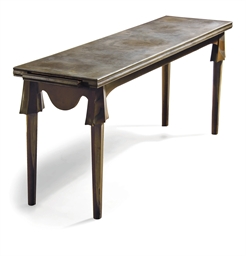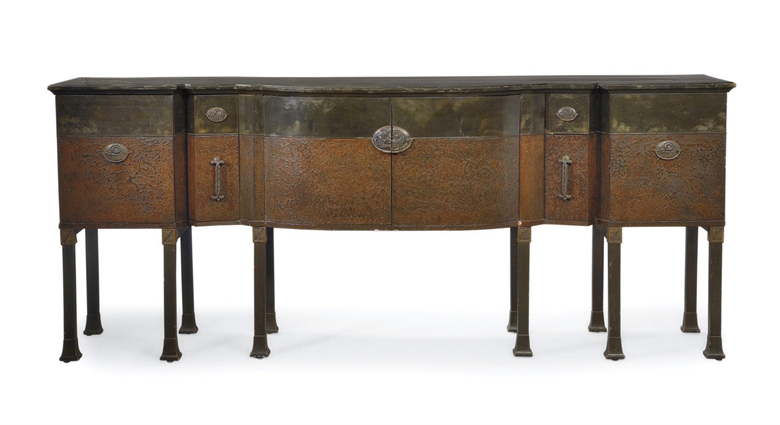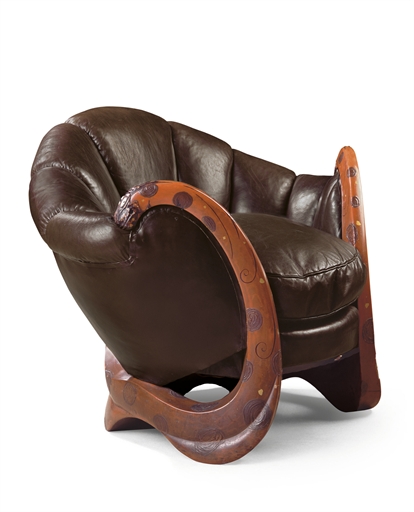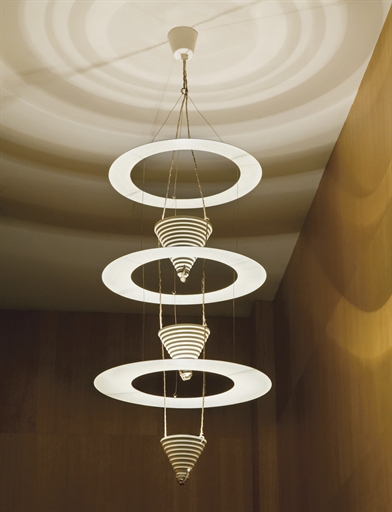
While the most iconic designs by Eileen Gray (1878-1976) are those that have been reproduced for decades—the black lacquer brick screen in MoMA’s collection or the circular chrome side table presently offered by Design Within Reach—the idiosyncratic architect and designer was also responsible for other unique and visionary examples of modernist design. Today, as part of the sale of the Yves Saint Laurent and Pierre Bergé collection at Christie’s, four rarely seen Gray designs will be auctioned, each representing a particular side of her technical and artistic talents.
Gray was born into an aristocratic Irish family in 1878. She entered London’s Slade School of Fine Arts in 1895. After moving to Paris in 1902, Gray studied, and later collaborated, with the renowned Japanese lacquer artist Seizo Sugawara, becoming one of the city’s leading designers in the medium. A console table in the sale (estimate $1.2-$1.8 million) shows the decorative surface effects she achieved with lacquer, here in alternating silver gray and orange-brown elements.

Lacquer stands out as well in the contrasting silver-flecked gray and textured red-brown surface of the enfilade that is believed to be on one of Gray’s earliest designed cabinet pieces (estimate $3.7-$6.3 million). Combining the form of an 18th century English sideboard with Japanese-inspired decoration, this example demonstrates Gray’s use of historical, modern, and exotic elements to create her own design vocabulary. The enfilade came from in the apartment of Mme Mathieu-Lévy, owner of the millinery salon Suzanne Talbot, on rue de Lota in Paris. Gray redesigned and furnished the interiors of the Lota apartment, which included an entrance hall of lacquer panels, her famous bateau-shaped Pirogue sofa, and an ostrich-egg ceiling light.
Also made for the Lota apartment is the Dragons armchair (estimate $2.5-$3.7 million), the centerpiece of the group and a superb example of Gray’s avant-garde style. Here Gray reinterprets popular Chinese iconography and creates a design that is both luxurious and fantastical.

The last example from the collection is the Satellite hanging light (estimate $750,000-$1 million), which Gray designed for the Maharaja of Indore and also for herself. Representing Gray’s transition away from lacquer to industrial materials and architecture, the lamp is composed of three suspended concentric rings of painted aluminum alternated with stepped conical shades. Embracing minimalism and futurism, the Satellite lamp foreshadows Gray’s most acclaimed work—her seaside house in southern France, known as E.1027.
While Gray’s designs have previously done well in the marketplace, these four lots, with their extraordinary provenance, are positioned to set world records.
Images from top to bottom: Portrait of Eileen Gray, 1926. Copyright Bernice Abbott. Console, c. 1920. Wood, and lacquer; height 25 5/8, width 60 7/8, depth 16 3/8 inches. Enfilade, c. 1915-17. Wood, lacquer, and metal; height 36 5/8, width 88 ½, depth 20 inches. Dragons armchair, c. 1917-19. Wood, lacquer, patinated silver-leaf inclusions, and brown leather upholstery; height 24, width 35 3/4, depth 26 3/8 inches. Satellite hanging lamp, c. 1925. Aluminum; height 53 1/8, diameter 18 7/8 inches. All copyright Christie’s Images Ltd. 2009.
